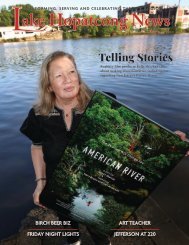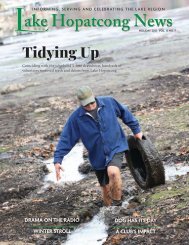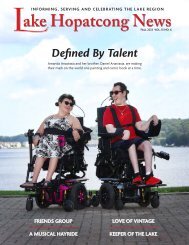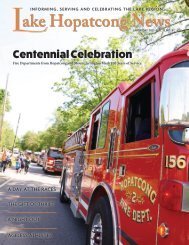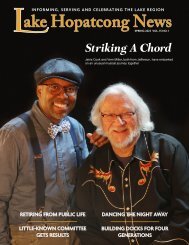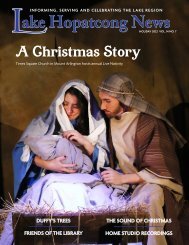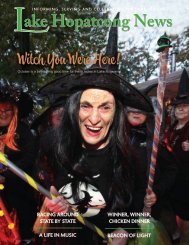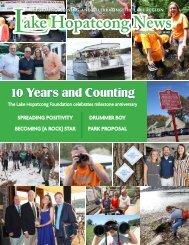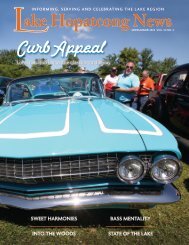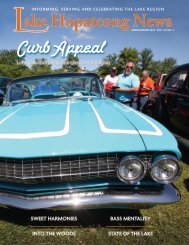Create successful ePaper yourself
Turn your PDF publications into a flip-book with our unique Google optimized e-Paper software.
34<br />
HISTORY<br />
During the first decades of the 20th<br />
century, when movies were in their<br />
infant stage and Hollywood was mostly orange<br />
groves, Fort Lee, New Jersey, was the center of<br />
American film production.<br />
New Jersey’s connection to the film industry<br />
started even earlier, when Thomas Edison and<br />
his West Orange company demonstrated the<br />
concept of motion pictures in 1891 with the<br />
Kinetoscope, a device that allowed one person<br />
at a time to view a strip of film passed rapidly<br />
between a lens and an electric light bulb.<br />
Edison anticipated the public would buy<br />
individual machines to view a film and never<br />
envisioned mass audiences for moving<br />
pictures. That innovation took place in Paris in<br />
1895, when the Lumière brothers unveiled their<br />
film projector, enabling groups to watch at the<br />
same time.<br />
While these early films were under a minute<br />
long, audiences were captivated by their ability<br />
to capture movement. It was not long before<br />
entrepreneurs saw the potential of this new<br />
technology.<br />
Edison’s Black Maria in West Orange,<br />
considered the world’s first film studio,<br />
was completed in 1893 and dozens of small<br />
companies soon sprang up on the East Coast<br />
to fill the growing demand for moving pictures.<br />
As the 20th century dawned, these early<br />
filmmakers invented an industry by constantly<br />
advancing film technique and technology.<br />
New York City had the largest concentration<br />
of early studios, and filmmakers quickly<br />
LAKE HOPATCONG NEWS <strong>Midsummer</strong> <strong>2023</strong><br />
Lake Hopatcong on the Silver Screen<br />
by MARTY KANE<br />
Photos courtesy<br />
of the<br />
LAKE HOPATCONG<br />
HISTORICAL<br />
MUSEUM<br />
discovered that New Jersey offered a wide<br />
variety of scenery just a short ferry ride away.<br />
The area around Fort Lee soon became<br />
a particularly popular film location due to<br />
its diverse landscape. The sheer cliffs of the<br />
Palisades stood in for canyons of the Wild<br />
West, while the Hudson River below could look<br />
like a seaside harbor, coastal stretch or even an<br />
ocean. The open plateaus and tall trees atop<br />
the Palisades could resemble the woods of<br />
England, and the town of Fort Lee itself—with<br />
its wood-frame houses, narrow streets and<br />
stone and granite businesses—could serve as<br />
Anytown, USA.<br />
Fort Lee welcomed the film industry with<br />
open arms. At its height, over a dozen studios<br />
operated within the town or in nearby Hudson<br />
Heights, Cliffside Park and Jersey City.<br />
Champion Studios opened in 1910 and was<br />
joined within the next few years by many of<br />
the studios that would soon dominate the new<br />
industry, including Universal, Goldwyn and Fox.<br />
The biggest entertainers of the day filmed<br />
in Fort Lee: Will Rogers, Rudolph Valentino,<br />
Lillian Gish, Douglas Fairbanks, Theda Bara,<br />
Fatty Arbuckle, Mabel Normand, Pearl White<br />
and Mary Pickford, along with the Barrymore<br />
family, who actually made their home in Fort<br />
Lee.<br />
One of the most influential figures in film<br />
history, D.W. Griffith, honed his craft by<br />
shooting nearly 100 pictures there.<br />
In addition to utilizing Fort Lee’s natural<br />
resources and studio backlots, filmmakers<br />
looked to other nearby locales to capture just<br />
the right background and scenery. This is what<br />
brought film to Lake Hopatcong. A large lake<br />
with resort hotels that was easily accessible by<br />
train made for a useful location.<br />
At least six filmmakers shot scenes at the lake<br />
in the 1910s, including Louis B. Mayer, Alice Guy<br />
Blaché and Léonce Perret.<br />
The most expensive and star-studded film<br />
shot at the lake was “Virtuous Wives,” Mayer’s<br />
first film. Filmed in 1918, it featured Anita<br />
Stewart, one of America’s first movie stars, in<br />
Left to right: Anita Stewart and William Boyd in 1918<br />
stand on Hudson Maxim’s dock in a scene from “Virtuous<br />
Wives.” (Lake Hopatcong Yacht Club can be seen in the<br />
background.) Mia Farrow and Jeff Daniels in “Purple<br />
Rose of Cairo,” filmed at Bertrand Island Park in 1983.<br />
a plot that called for a country estate and an<br />
out-of-control motorboat.<br />
Director George L. Tucker found the type<br />
of lakefront scenery he was seeking at Lake<br />
Hopatcong, along with volunteers willing to<br />
loan their motorboats. The film made use<br />
of the Phoebe Snow (a lake tour boat) and<br />
locales such as Air Castle Isles, Hudson Maxim’s<br />
boathouse and the Bertrand Island beach.<br />
Another notable director who filmed at the<br />
lake was Alice Guy Blaché, a French film pioneer<br />
who wrote, directed and produced films as well<br />
as running her own studio at Fort Lee.<br />
The September 20, 1913 issue of Moving<br />
Picture World reported that “Madame<br />
Blaché, president of the Solax Company,<br />
and a company of 50 people, together with<br />
property men and numerous assistants and an<br />
equipment of three wagon loads of properties<br />
and sceneries, have left for Lake Hopatcong<br />
where numerous scenes in the forthcoming<br />
Solax feature, entitled Rogues of Paris will<br />
be staged. The transfer of the company and<br />
equipment to this famous lake resort means an<br />
expense of more than $2,000.”<br />
The Fort Lee Film Commission lists this film<br />
as one of the most notable made by Blaché at<br />
Solax.<br />
At the Lake Hopatcong Historical Museum,<br />
we have long thought it would be fascinating<br />
to see these professional movies shot at the<br />
lake during its peak resort years. Until last year,<br />
however, it was believed that all such films<br />
were lost, with only still photos surviving.<br />
This is not surprising, as it is estimated that<br />
only 10 percent of films made between 1910<br />
and 1920 still exist. The nitrate film used in<br />
early motion pictures was not only extremely<br />
unstable and flammable but decomposed and<br />
turned to powder if not stored in optimum<br />
conditions.<br />
In addition, silent films were not considered<br />
valuable once “talkies” came along. With<br />
television, DVDs and on-demand viewing<br />
decades in the future, there was no market for<br />
silent films after their initial release. Prints were<br />
often destroyed to retrieve<br />
the silver contained within<br />
nitrate stock, which sometimes<br />
financed a filmmaker’s next<br />
project.<br />
We were aware of an August<br />
31, 1918 Lake Hopatcong Breeze<br />
report that “an independent<br />
motion picture company under<br />
the direction of M. Perret… will<br />
arrive at the Alamac [Hotel]…<br />
and will remain for several days.”<br />
The article states that scenes<br />
would be shot at the hotel and<br />
around the lake for a French



